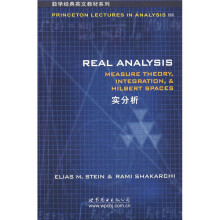数学经典英文教材系列:实分析

Foreword
Introduction
1 Fourier series: completion
2 Limits of continuous functions
3 Length of curves
4 Differentiation and integration
5 The problem of measure
Chapter 1. Measure Theory
1 Preliminaries
2 The exterior measure
3 Measurable sets and the Lebesgue measure
4 Measurable functions
4.1 Definition and basic properties
4.2 Approximation by simple functions or step functions
4.3 Littlewoods three principles
5* The Brunn-Minkowski inequality
6 Exercises
7 Problems
Chapter 2. Integration Theory
1 The Lebesgue integral: basic properties and convergence theorems
2 The space L1 of integrable functions
3 Fubinis theorem
3.1 Statement and proof of the theorem
3.2 Applications of Fubinis theorem
4* A Fourier inversion formula
5 Exercises
6 Problems
Chapter 3. Differentiation and Integration
1 Differentiation of the integral
1.1 The Hardy-Littlewood maximal function
1.2 The Lebesgue differentiation theorem
2 Good kernels and approximations to the identity
3 Differentiability of functions
3.1 Functions of bounded variation
3.2 Absolutely continuous functions
3.3 Differentiability of jump functions
4 Rectifiable curves and the isoperimetric inequality
4.1 Minkowski content of a curve
4.2* Isoperimetrie inequality
5 Exercises
6 Problems
Chapter 4. Hilbert Spaces: An Introduction
1 The Hilbert space L2
2 Hilbert spaces
2.1 Orthogonality
2.2 Unitary mappings
2.3 Pre-Hilbert spaces
3 Fourier series and Fatous theorem
3.1 Fatous theorem
4 Closed subspaees and orthogonal projections
5 Linear transformations
5.1 Linear flmetionals and the Riesz representation the-orem
5.2 Adjoints
5.3 Examples
6 Compact operators
7 Exercises
8 Problems
Chapter 5. Hilbert Spaces: Several Examples
1 The Fourier transform on L2
2 The Hardy space of the upper half-plane
3 Constant coefficient partial differential equations
3.1 Weak solutions
3.2 The main theorem and key estimate
4* The Dirichlet principle
4.1 Harmonic functions
4.2 The boundary value problem and Diriehlets principle
5 Exercises
6 Problems
Chapter 6.Abstract Measure and Integration Theory
Chapter 7.Hausdorff Measure and Fractals
Notes and References
Bibliography
Symbol Glossary
Index
Introduction
1 Fourier series: completion
2 Limits of continuous functions
3 Length of curves
4 Differentiation and integration
5 The problem of measure
Chapter 1. Measure Theory
1 Preliminaries
2 The exterior measure
3 Measurable sets and the Lebesgue measure
4 Measurable functions
4.1 Definition and basic properties
4.2 Approximation by simple functions or step functions
4.3 Littlewoods three principles
5* The Brunn-Minkowski inequality
6 Exercises
7 Problems
Chapter 2. Integration Theory
1 The Lebesgue integral: basic properties and convergence theorems
2 The space L1 of integrable functions
3 Fubinis theorem
3.1 Statement and proof of the theorem
3.2 Applications of Fubinis theorem
4* A Fourier inversion formula
5 Exercises
6 Problems
Chapter 3. Differentiation and Integration
1 Differentiation of the integral
1.1 The Hardy-Littlewood maximal function
1.2 The Lebesgue differentiation theorem
2 Good kernels and approximations to the identity
3 Differentiability of functions
3.1 Functions of bounded variation
3.2 Absolutely continuous functions
3.3 Differentiability of jump functions
4 Rectifiable curves and the isoperimetric inequality
4.1 Minkowski content of a curve
4.2* Isoperimetrie inequality
5 Exercises
6 Problems
Chapter 4. Hilbert Spaces: An Introduction
1 The Hilbert space L2
2 Hilbert spaces
2.1 Orthogonality
2.2 Unitary mappings
2.3 Pre-Hilbert spaces
3 Fourier series and Fatous theorem
3.1 Fatous theorem
4 Closed subspaees and orthogonal projections
5 Linear transformations
5.1 Linear flmetionals and the Riesz representation the-orem
5.2 Adjoints
5.3 Examples
6 Compact operators
7 Exercises
8 Problems
Chapter 5. Hilbert Spaces: Several Examples
1 The Fourier transform on L2
2 The Hardy space of the upper half-plane
3 Constant coefficient partial differential equations
3.1 Weak solutions
3.2 The main theorem and key estimate
4* The Dirichlet principle
4.1 Harmonic functions
4.2 The boundary value problem and Diriehlets principle
5 Exercises
6 Problems
Chapter 6.Abstract Measure and Integration Theory
Chapter 7.Hausdorff Measure and Fractals
Notes and References
Bibliography
Symbol Glossary
Index
Stein,在国际上享有盛誉,现任美国普林斯顿大学数学系教授。
他是当代分析,特别是调和分析和分析领域领袖人物之一。古典调和分析最困难问题之一是推广到多维。他是多维欧氏调和分析的创造者之一,为此他发展了许多先进工具如奇异积分、Radon变换、极大函数等。他还发展了多个实变元的Hardy空间理论,推广了1971年F. John和L. Nirenberg的重要发现:即Hardy空间与BMO空间的对偶。在群上的调和分析方面也有贡献,例如同R.Kunze一起发现所谓Kunze-Stein现象。除此之外,他对多复变问题也做出了突出成绩。
除了研究工作之外,他的许多著作成为影响学科发展的重要参考文献。为此,他荣获1984年美国数学会在论述方面的Steele奖。
由于他的成就,他在1974年被选为美国国家科学院院士,1982年被选为美国文理学院院士,1993年获得瑞士科学院颁发的Schock奖。1999年获得世界性Wolf数学奖。
他是当代分析,特别是调和分析和分析领域领袖人物之一。古典调和分析最困难问题之一是推广到多维。他是多维欧氏调和分析的创造者之一,为此他发展了许多先进工具如奇异积分、Radon变换、极大函数等。他还发展了多个实变元的Hardy空间理论,推广了1971年F. John和L. Nirenberg的重要发现:即Hardy空间与BMO空间的对偶。在群上的调和分析方面也有贡献,例如同R.Kunze一起发现所谓Kunze-Stein现象。除此之外,他对多复变问题也做出了突出成绩。
除了研究工作之外,他的许多著作成为影响学科发展的重要参考文献。为此,他荣获1984年美国数学会在论述方面的Steele奖。
由于他的成就,他在1974年被选为美国国家科学院院士,1982年被选为美国文理学院院士,1993年获得瑞士科学院颁发的Schock奖。1999年获得世界性Wolf数学奖。
本书由在国际上享有盛誉普林斯大林顿大学教授Stein等撰写而成,是一部为数学及相关专业大学二年级和三年级学生编写的教材,理论与实践并重。为了便于非数学专业的学生学习,全书内容简明、易懂,读者只需掌握微积分和线性代数知识。关于本书的详细介绍,请见“影印版前言”。
本书已被哈佛大学和加利福尼亚理工学院选为教材。与本书相配套的教材《傅立叶分析导论》和《复分析》也已影印出版。
本书已被哈佛大学和加利福尼亚理工学院选为教材。与本书相配套的教材《傅立叶分析导论》和《复分析》也已影印出版。
比价列表
公众号、微信群
 缺书网
缺书网微信公众号
 扫码进群
扫码进群实时获取购书优惠





